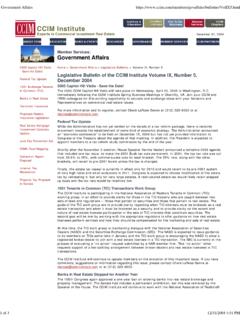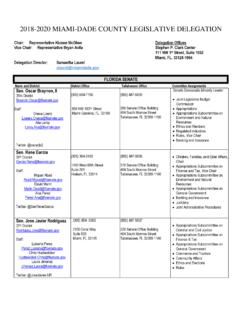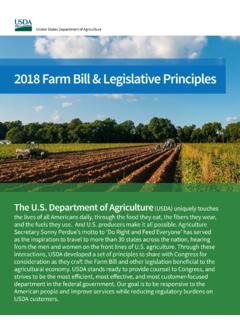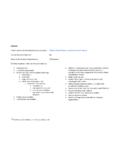Transcription of RECOGNITION OF INHERENT RIGHTS THROUGH …
1 1 RECOGNITION OF INHERENT RIGHTS THROUGH legislative INITIATIVES These materials were prepared by David C. Nahwegahbow of the firm, Nahwegahbow, Nadjiwan, Corbiere, North Bay, Ontario for a Conference held in Toronto, Ontario hosted by Indigenous Bar Association, October 18, 2002. 2 RECOGNITION OF INHERENT RIGHTS THROUGH legislative INITIATIVES INTRODUCTION The Minister of Indian affairs , Robert Nault, caused an uproar recently with comments he made during a CBC interview on October 7, 2002, when he announced that the federal government was walking away from a number of negotiating tables across the country that he deemed to be unproductive. These tables thirty in all, out of a total of approximately 170 deal with a range of matters, according to the Minister, from specific claims to self-government negotiations and comprehensive claims within the BC Treaty Process.
2 One of the things that was startling about the Minister s announcement was his rationale for walking away from certain tables. He characterized some of the demands of First Nation leaders as excessive, such that it would be bad faith to continue to negotiate under such circumstances. When asked by the interviewer to give us an example of where you think the other side has been negotiating in bad faith, or where their demands are considered preposterous , the Minister responded: For example, jurisdiction. If certain jurisdictions are asked for that are outside of my mandate .. for example, some First Nation leaders have been promoting the whole notion of being sovereign, and being sovereign meaning that they don t need delegated authority from the federal government, that they can make their own laws, that s way outside of my mandate.
3 That is an example when it is important for the Minister and the negotiator to send the message that this is not on and it is not part of the framework agreement that we signed. 1 I find these comments shocking with respect to self-government because they directly contradict the Liberal government s self-government policy, which is stated to recognize the INHERENT right of self-government as an existing Aboriginal and treaty In this paper, I will argue in favour of the INHERENT right of self-government, and that if the 1 Transcript of Interview done by Mary Lou Finley with Minster Nault, CBC, As It Happens, October 7, 2002. 3 federal Parliament is to legislate in respect of this right it must do so THROUGH legislative initiatives that are based on RECOGNITION .
4 I put forward Minister Nault s comments as a context for this presentation because I have been asked to, among other things, assess the Minister s recently re-introduced legislative proposal, the First Nations Governance Act, as an example of RECOGNITION of INHERENT RIGHTS THROUGH legislative initiatives. Although it would appear that the proposed First Nations Governance Act, now known as Bill C-7 (formerly Bill C-61), does not purport to recognize the INHERENT right of self-government, the Bill and the Minister s comments do raise some questions which are germane to our discussion. These questions, which shall serve as an outline for this presentation, are as follows: $ Do Aboriginal peoples possess an INHERENT right of self-government? $ Is it appropriate and possible to recognize the INHERENT right of self-government THROUGH legislative initiatives?
5 $ If such RECOGNITION is possible and appropriate, what will the legislative initiative look like and how will it operate? $ What is the Canadian federal policy on RECOGNITION of the INHERENT right of self-government? $ What are the international trends, do they support RECOGNITION ? 2 Federal Policy Guide, Aboriginal Self-Government: The Government of Canada s Approach to Implementation of the INHERENT Right and the Negotiation of Aboriginal Self-Government, 1995. 4 THE INHERENT RIGHT OF SELF GOVERNMENT The first question is whether there is an INHERENT right of self-government and, more specifically, whether it is possessed by the Aboriginal group in question. This is an important question because if Aboriginal peoples do possess that right, then, the right is protected as an existing Aboriginal and treaty right by s.
6 35 of the Constitution Act, 1982, and cannot be unilaterally regulated by the federal legislation. Also, because of the fiduciary obligations arise from these RIGHTS , the federal Parliament and the federal government have a duty to ensure that their laws and actions do not infringe Aboriginal and treaty RIGHTS without proper justification .3 Moreover, since Aboriginal peoples can be expected to resist legislation that potentially infringes upon their constitutional RIGHTS like any other people who value their constitutional RIGHTS the only way in which the INHERENT right of self-government can be legislated, manageably and with some level of cooperation, is if the legislation is based on RECOGNITION . Under s. 35, self-government as an Aboriginal right , is based on the notion accepted by the Courts, that Aboriginal nations were organized societies with their own laws and customs when Europeans arrived in North In terms of treaty RIGHTS , it is argued that either the right of self-government continues as a residual Aboriginal right which was not extinguished by treaty, or that the right of self-government is itself a treaty right which was recognized when the Crown entered into treaties with Indian nations.
7 The INHERENT right of self-government has not yet been legally recognized by the Supreme Court of Canada. However, as aforesaid, it has been recognized in policy by the federal government; and the Royal Commission on Aboriginal Peoples has recognized it. Moreover, the basis and framework for its RECOGNITION has been established by the Supreme Court of Canada in Sioui5, Van der Peet6 , and Pamajewon7; and the BC Supreme Court recognized an INHERENT right of 3 R. v. Sparrow, [1900] 3 160 ( ) 4 See for example: Calder v. Attorney General of British Columbia, [1973] 313, at p. 328. 5 R. v Sioui, [1990] 3 127 ( ) 6 R. v Van der Peet, [1996] 4 177 ( ) 7 R. v Pamajewon, [1996] 4 164 ( ) 5 self-government in the Campbell Case8. Aspects of this right, namely matters of leadership selection/elections, also find expression as Aboriginal and treaty RIGHTS in a more specific way as customs.
8 Section. 2(1)(b) of the Indian Act9 -- which is a form of legislative RECOGNITION of the INHERENT right of self-government -- recognizes councils chosen according to the custom of the band . This has spawned considerable case law, including the case of Bone v. Sioux Valley Indian Band No. 290, wherein Justice Heald of the Federal Court, said: [i]t does not confer a power upon a Band to develop a custom for selecting its council. Rather, it recognizes that an Indian Band has customs, developed over decades if not centuries, which may include a custom for selecting the Band's Chief and Councillors. The definition of "council of a band" acknowledges that prior to the enactment of the Indian Act in 1951, Indian Bands had their own methods for selecting the Band Council.
9 The power or ability to continue choosing the Band Council in the customary manner is left intact by the Indian Act, except in those cases where the power is removed by a ministerial order under subsection 74(1) of the in my view the Band may exercise this INHERENT power unrestrained by subsection 2(3)(a) of the Indian [emphasis added] Customs respecting the manner of selecting leaders, particularly historic customs, comprise the system of laws of Aboriginal societies, which Canadian common law recognizes as the basis of Aboriginal RIGHTS . As former Chief Justice Lamer said in Van der Peet, in order to be an Aboriginal right, an activity must be an element of a practice, custom or 11 It would be appropriate at this stage to have a closer look at the framework for proving Aboriginal RIGHTS set out in Van der The same legal principles are applicable to 8 Campbell v British Columbia (Attorney General), [2000] 4 1 ( ) 9 Indian Act, 1985, , as amended 10 [1996] 3 54 ( ), at p.
10 65 11 Supra, note 6, at p. 201[emphasis added] 12 However, many people are critical of the current domestic law with respect to Aboriginal and treaty RIGHTS particularly its interpretation of the historic treaties. See for example, the paper 6 asserting customs regarding self-government. The Court has made it clear that it will review all Aboriginal RIGHTS claims on a case-by-case prepared by Sharon Venne, for the Building the Momentum: A Conference on Implementing the Recommendations of the Royal Commission on Aboriginal Peoples, April 1999 entitled, Treaty-making and its Potential for Conflict Resolution between Indigenous Nations and the Canadian State. [hereinafter Venne] In her review of the interpretation of the treaties between Indigenous peoples and the Canadian state she concludes: Indigenous treaties have merited meagre consideration by the legal history of the Canadian state.







